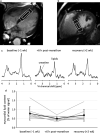Marathon running transiently depletes the myocardial lipid pool
- PMID: 32869950
- PMCID: PMC7460059
- DOI: 10.14814/phy2.14543
Marathon running transiently depletes the myocardial lipid pool
Abstract
Lipids, stored as intracellular triacylglycerol droplets within the myocardium, serve as an important source of energy, particularly in times of prolonged increased energy expenditure. In only a few studies, the acute effects of exercise on such ectopic myocardial lipid storage were investigated. We studied the dynamic behavior of the myocardial lipid pool in response to completing the 2017 Amsterdam Marathon using proton magnetic resonance (MR) spectroscopy (1 H-MRS). We hypothesized that the prolonged increased myocardial energy demand of running a marathon could shift the balance of myocardial triacylglycerol turnover from triacylglycerol synthesis toward lipolysis and mitochondrial fatty acid β-oxidation, and decrease the myocardial lipid pool. We employed two 3 Tesla MR systems in parallel to noninvasively examine endurance-trained healthy men (n = 8; age 50.7 [50.1-52.7] y) at 1 week prior (baseline), <6 hr after finishing the marathon (post-marathon), and 2 weeks thereafter (recovery). Exercise intensity was 89 ± 6% of the age-predicted maximal heart rate, with a finish time of 3:56 [3:37-4:42] h:min. Myocardial lipid content was 0.66 [0.58-0.87]% of the total myocardial water signal at baseline, was lower post-marathon (0.47 [0.41-0.63]% of the total myocardial water signal), and had restored to 0.55 [0.49-0.83]% of the total myocardial water signal at recovery, representing a transient marathon running-induced depletion of 29 ± 24% (p = .04). The magnitude of this myocardial lipid pool depletion did not correlate with exercise intensity (r = -0.39; p = .39), nor with marathon finishing time (ρ = 0.57; p = .15). Our data show that prolonged high-intensity exercise can induce a transient depletion of the myocardial lipid pool, reinforcing the dynamic nature of ectopic triacylglycerol storage under real-life conditions of extreme endurance exercise.
Keywords: endurance exercise; lipid metabolism; myocardium; proton magnetic resonance spectroscopy; triglycerides.
© 2020 The Authors. Physiological Reports published by Wiley Periodicals LLC on behalf of The Physiological Society and the American Physiological Society.
Conflict of interest statement
The authors declare no potential conflict of interest.
Figures


References
-
- Aengevaeren, V. L. , Froeling, M. , Hooijmans, M. T. , Monte, J. R. , van den Berg‐Faay, S. , Hopman, M. T. E. , … Eijsvogels, T. M. H. (2020). Myocardial injury and compromised cardiomyocyte integrity following a marathon run. JACC: Cardiovascular Imaging, 13, 1445–1447. - PubMed
-
- Bucher, J. , Krüsi, M. , Zueger, T. , Ith, M. , Stettler, C. , Diem, P. , … Christ, E. (2014). The effect of a single 2 h bout of aerobic exercise on ectopic lipids in skeletal muscle, liver and the myocardium. Diabetologia, 57, 1001–1005. - PubMed
-
- de Heer, P. , Bizino, M. B. , Lamb, H. J. , & Webb, A. G. (2016). Parameter optimization for reproducible cardiac 1H‐MR spectroscopy at 3 Tesla. Journal of Magnetic Resonance Imaging, 44, 1151–1158. - PubMed
-
- Griffin, J. L. , Williams, H. J. , Sang, E. , & Nicholson, J. K. (2001). Abnormal lipid profile of dystrophic cardiac tissue as demonstrated by one‐ and two‐dimensional magic‐angle spinning 1H NMR spectroscopy. Magnetic Resonance in Medicine, 46, 249–255. - PubMed
Publication types
MeSH terms
Substances
LinkOut - more resources
Full Text Sources

